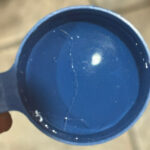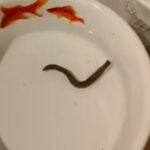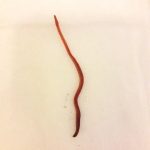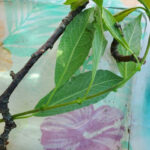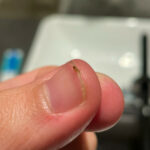There are two types of worm questions we receive: those that deal with strange worms that people find, and those that deal with strange worms that people find that are compromising some aspect of their life, generally their gardening activities. Our most recent reader question is of the latter variety, with a reader writing in about “fat healthy black 4-5 inch [or 10-13 centimeter] worms” that are “eating up [her] four o’clocks.” (A four o’clock, or Mirabilis jalapa, is a type of colorful and fragrant flower, for the record.) This seems straightforward enough, except that the worms our reader found have gold “lettering” on their backs that resemble the characters of Asian languages. The soft ball we thought we had been pitched ended up taking a late break, and everyone knows that a late-breaking curve ball is particularly hard to hit. Of course, our reader was wondering what these fat, black worms might be, and so we will do our best to provide her with an answer.
We will begin by stating the obvious fact that it is not at all uncommon to find worms in your garden. Indeed, one sign of a healthy garden is the number of worms within its soil. Moreover, worms are very good for your garden, as they dig tunnels through the soil, which allows air and moisture to more easily travel through it. Worms also excrete waste, called castings or vermicompost, in the gardens in which they live, and these castings are excellent for your soil. Worm castings facilitate plant growth and help plants stay healthy, making them less susceptible to diseases and pests. Worm castings are basically plant vitamins. So, before you go on a mission to eliminate worms from your garden, remember the enormous amount of good they do for your plants. Of course, if the worms are eating your plants, this is a problem, and pointing out the benefits of worms will probably not provide much solace to our reader.
What type of worm might you find in your garden? Frequently, you will find nightcrawlers, which tend to be rather long – up to 8-10 inches (or 20-25 centimeters), in fact. Of course, not all nightcrawlers are this long, and they could certainly be in the length range described by our reader. Nightcrawlers can also be black and fat, giving them the appearance of being “healthy,” to use our reader’s word. (Their plumpness is one reason they are commonly used for fish bait.) There is a type of nightcrawler called Eisenia hortensis that just about meets our reader’s description of the worms she found perfectly, except, not surprisingly, these nightcrawlers do not have gold lettering on their backs that look like Chinese characters (or the characters of any other Asian language, for that matter). Based on most of the description supplied by our reader, it does seem like she is dealing with some type of earthworm, but we simply do not know of any worms with gold Asian characters on their backs.
There is also the matter of the worms eating the reader’s flowers, and this also perplexes us. Earthworms simply don’t eat the plants in your garden, which leads us to speculate that our reader might be dealing with some type of caterpillar. Caterpillars do eat plants, including flowers, and they are often multicolored, meaning that designs resembling gold Asian characters might be found on their bodies. We don’t know of any off the top of our heads, and we weren’t able to find any in our search for an answer, but it is possible.
So, unfortunately, we must end were be began: with uncertainty. Half of the reader’s description of the creatures she found (that they are black, fat, and healthy) seems to fit the appearance of a nightcrawler, but the other half – the part about them eating her flowers and having a strange design on their backs – better matches the description of some type of caterpillar. You might find either creature in your garden, to further complicate matters. Maybe our reader is misattributing the damage done to her flowers to nightcrawlers, nightcrawlers that happen to have a strange pattern on their back, and her plants are actually being consumed by some other creature? Alas, we simply don’t know.
But we invite this reader – or any other similarly situated reader – to submit a picture of this beast, and with that we can probably be of more precise assistance.
All About Worms is always free, always reader-supported. Your tips via CashApp, Venmo, or Paypal are appreciated! Receipts will come from ISIPP Publishing.




